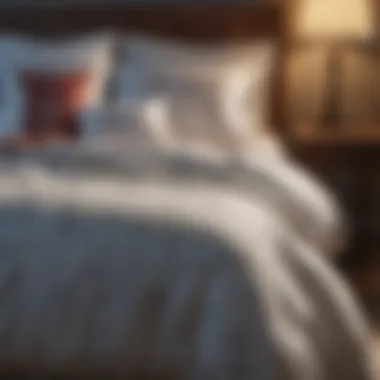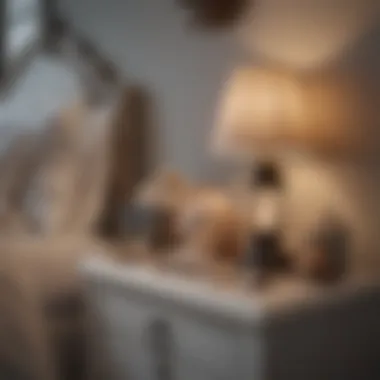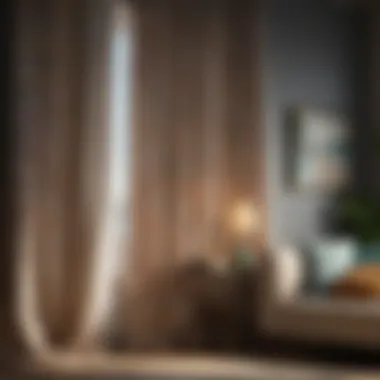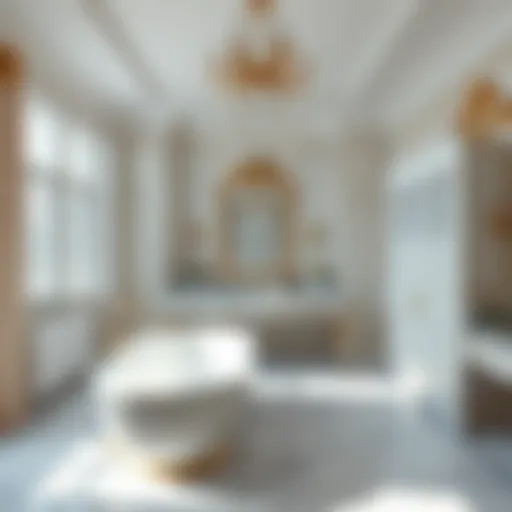Exploring Nautical Bedroom Accessories for Style


Intro
Nautical themes have long captivated our imagination, bringing a sense of serenity and adventure to various spaces, particularly the bedroom. As we explore nautical bedroom accessories, we will highlight their aesthetic appeal and functional benefits. These accessories fulfill more than just decorative needs; they create an atmosphere that connects us to the sea and nature. In this guide, we will look at trends, color choices, material selection, and practical tips for arrangement and maintenance.
Trending Styles
Modern Minimalism
Modern minimalism in nautical design emphasizes clean lines and simplicity. This style integrates essential ocean elements without overwhelming the space. Accessories like simple rope curtains, sleek bedding in shades of blue, or horizontal striped throw pillows can elevate the room’s ambiance. The goal is to create a tranquil retreat that speaks subtly of sea voyages.
Cozy Rustic
Rustic nautical decor combines warmth with charm. Think weathered wood, soft fabrics, and earthy tones. Accessories such as driftwood sculptures, vintage anchors, or textured rugs create a comforting yet coastal vibe. This style invites elements of the beach into a brilliantly cozy haven.
Color Palettes
Calming Neutrals
Neutral colors dominate modern nautical themes. Shades such as soft whites, sandy beiges, and light grays create a calming atmosphere. These tones can act as a backdrop for other accessories, allowing them to shine without clashing.
Bold Accents
In contrast, bold accents can energize a space. Deep navy or vibrant coral can bring life to a room. You could consider adding colorful lamps or wall art to provide pops of brilliance against a neutral palette. Combining bold accents with softer tones can balance the room beautifully.
"The goal of nautical decor is to evoke the essence of the sea while ensuring that the bedroom remains a sanctuary for rest and relaxation."
Materials and Textures
Selecting materials is crucial for achieving the right nautical look. Natural fibers like cotton, linen, and burlap work well for bedding and curtains. Incorporating textures such as woven baskets or braided rugs enhances the overall warmth and comfort of the space.
Tips for Arrangement
Arranging these accessories thoughtfully can make a significan difference. Here are a few tips:
- Use a large anchor as a focal point on one wall.
- Layer rugs for added texture.
- Create symmetry with matching bedside lamps.
Maintaining Your Nautical Accessories
Regular maintenance ensures longevity. Dust soft items like pillows or throws weekly. Wipe down wood and metallic accents monthly to keep everything looking fresh.
Understanding Nautical Decor
Understanding nautical decor is a vital aspect of enhancing interior spaces, particularly in bedrooms. This style offers more than just aesthetic appeal; it evokes a sense of tranquility and adventure that resonates with many homeowners. Nautical decor incorporates elements associated with the sea, such as colors, materials, and themes that reflect maritime life. This can transform ordinary bedrooms into serene retreats that capture the essence of coastal living.
Definition of Nautical Decor
Nautical decor refers to an interior design style inspired by maritime themes and oceanic elements. This style typically features a palette dominated by blue, white, and natural colors, resembling the colors of the sea and sand. Common motifs include anchors, ropes, boats, and marine life. The use of textures like canvas, wood, and metals further enhances the maritime experience, making the space feel inviting and authentic.
Historical Context
The history of nautical decor traces back to seafaring societies where maritime culture played a crucial role in daily life. During the 19th century, with the rise of shipbuilding and the exploration of new frontiers, nautical elements began to creep into home decor. Fishermen's cottages often sported this style, showcasing their connection to the sea. Over time, as coastal living became popular, nautical design ventured beyond just functional spaces into homes, resorts, and urban settings, reflecting a shift in cultural appreciation for maritime aesthetics.
Contemporary Relevance
In today's world, the relevance of nautical decor has not waned. Many homeowners seek to incorporate this style to evoke feelings of calmness and relaxation in their bedrooms. Nautical decor serves as a reminder of beach holidays, peaceful oceans, and leisurely sails. Moreover, with trends leaning toward sustainability, the use of reclaimed materials in nautical accessories aligns with eco-friendly practices. This has made nautical decor increasingly appealing for those looking to create stylish yet sustainable living spaces.
"Nautical decor is not merely an aesthetic; it is a lifestyle choice that infuses calm and adventure into your home."
By understanding the foundations of nautical decor, homeowners can thoughtfully select accessories and design elements that resonate with their personal tastes while embracing the tranquility of the sea.
Key Elements of Nautical Accessories
Understanding the fundamental components of nautical bedroom accessories is essential for achieving a cohesive and appealing design. Each element contributes to the nautical theme, enhancing both aesthetics and functionality in your living space. The right colors, materials, and patterns can create an environment that reflects a coastal lifestyle while providing comfort and charm. An informed selection will not only elevate your bedroom but also resonate with the nautical spirit.
Color Schemes


Classic Blue and White
Classic Blue and White is a cornerstone of nautical design. This color scheme embodies the essence of the sea, evoking feelings of calmness and clarity. The predominant blue hue reflects the ocean, while white signifies the endless sky and offers a fresh contrast. This combination remains a popular choice because it combines brilliance with simplicity. A key characteristic is its versatility—blue and white can be integrated into both vintage and modern designs, allowing for seamless decoration.
One unique feature of Classic Blue and White is its ability to make spaces feel larger and more open. This can be especially beneficial in smaller bedrooms. However, an overuse of these colors might create a sterile environment if not balanced with other elements or materials.
Earthy Tones and Neutrals
Earthy Tones and Neutrals provide a grounding effect in nautical decor. Shades like sandy beige, terracotta, and muted greens create an inviting and warm atmosphere. This color palette is a beneficial choice as it reflects the natural elements found in coastal environments, thus resonating with those seeking a more organic aesthetic.
The unique feature of Earthy Tones is their ability to promote relaxation and comfort, making them ideal for restful spaces. However, they might lack the vibrancy of bolder colors and could cause a room to feel subdued if not paired correctly with lively accents.
Accent Colors
Accent Colors bring a touch of personality to nautical accessories. Shades such as coral, seafoam green, and sunny yellow can infuse energy into the room. These colors serve as vibrant contrasts against the more dominant hues of blue and white or earthy tones.
The key characteristic of accent colors is their ability to highlight focal points and create visual interest. This makes them a popular choice for those looking to add a playful touch to their design. One unique feature of using accent colors is their capacity to be easily updated. You can change throw pillows, artwork, or decor items to refresh the look. However, overuse may overwhelm the primary color scheme, so it is crucial to apply them thoughtfully.
Materials Used
Wood
Wood is an integral part of nautical decor, symbolizing the shipbuilding heritage of the maritime world. It adds warmth and texture, creating a cozy atmosphere in bedrooms. Common types include reclaimed wood or driftwood, which enhances the nautical theme due to their weathered appearance.
The key characteristic of wood is its durability and timeless appeal, making it a beneficial choice for furniture and accessories. The natural variations in grain and color create unique pieces for any space. The unique feature of wood is that it can be easily stained or painted, allowing for customization. However, wood requires careful maintenance to avoid decay, especially in humid environments.
Canvas
Canvas is another essential material in nautical decor, frequently used in textiles and wall art. It has a rugged texture that conveys strength and resilience, mirroring boat sails and marine materials.
The key characteristic of canvas is its ability to withstand wear and tear, making it a popular choice for bedding, pillows, and curtains. Its durability contributes to long-lasting aesthetics. A unique feature of using canvas is the variety of designs and prints available, which can easily reflect a personal style. However, it may need consistent cleaning to prevent fading, especially in direct sunlight.
Metals
Metals like brass, copper, and iron are often used in accent pieces and fixtures. These materials introduce an industrial touch to nautical themes, often seen in light fixtures or decorative items like anchors and ropes.
The key characteristic of metals is their reflective quality, which can brighten spaces and add sophistication. They are beneficial choices for creating focal points and contrasts with softer materials. One unique aspect of metals is their adaptability; they can be polished, patinated, or painted to suit different design needs. However, they may require regular maintenance to prevent tarnishing or rust.
Patterns and Textures
Stripes
Stripes are synonymous with nautical design, echoing the sails of ships and seaside cabanas. They can be presented in various forms, from bold lines to subtle pinstripes.
The key characteristic of stripes is their ability to add a sense of structure and rhythm to a room. This makes them a beneficial choice for bedding, rugs, and curtains. A unique feature of stripes is their versatility; they can be horizontal or vertical, impacting the perception of space. Still, too many stripes can create visual clutter if not coordinated carefully.
Plaids
Plaids introduce an array of colors and textures that evoke the charm of coastal living. This pattern can be found in blankets, upholstery, or even wall decor.
The key characteristic of plaids is their warmth and familiarity, which contributes to a cozy ambiance. They can be beneficial choices for adding layers to a design. The unique aspect of plaids is their complexity; they can mix well with simpler patterns or colors. However, bold plaid patterns may clash if not combined thoughtfully with other elements.
Sailing Themes
Sailing Themes encompass a variety of motifs like boats, anchors, and waves. These designs are often prominent in wall art and decorative accessories.
The key characteristic of sailing themes is their direct representation of nautical life, making them a beneficial choice for achieving an authentic atmosphere. They easily evoke feelings of adventure and exploration. The unique feature is that they cater to all ages, making them a timeless design element. However, overuse can lead to a theme that appears gimmicky instead of elegant.
Types of Nautical Bedroom Accessories
Understanding the types of nautical bedroom accessories is essential for anyone aiming to transform their space into a marine haven. These accessories contribute both aesthetic and functional benefits. They serve not merely as decor but also enhance the atmosphere, creating a theme that is both engaging and comfortable. Selecting the right accessories can elevate the overall design while providing practical advantages.
Bedding and Textiles
Comforters and Duvets
Comforters and duvets are pivotal in setting the tone of a nautical-themed room. Their primary role is to provide warmth and comfort, making them indispensable in any bedroom setting. One key characteristic is their designs, which often incorporate nautical motifs like anchors or sea creatures. This makes them a popular choice for those looking to infuse a marine spirit into their rooms.
These bedding items are typically available in various materials, including cotton and linen, which add unique texture and comfort. Their unique feature lies in their versatility; they can easily be switched out seasonally, allowing for frequent updates to the room's look. While they are generally easy to care for, special attention should be given to the washing instructions to maintain their designs.


Pillows and Cushions
Pillows and cushions play a significant role in defining the ambiance of the nautical bedroom. They add layers of comfort and style, inviting relaxation. A highlighted aspect is the variety of sizes and shapes available, which enables creative arrangements. Nautical-themed cushions often feature designs like stripes and maritime symbols.
These accessories can serve dual functions, acting as decorative elements and providing support for seating or lying down. However, their unique feature is their need for regular fluffing and cleaning, especially for those made from more delicate fabrics. They can gather dust or lose shape if not cared for properly, impacting their longevity and aesthetic appeal.
Throws and Quilts
Throws and quilts serve as practical and decorative elements within a nautical theme. They add warmth and texture to the bedding setup. The notable characteristic is their ability to complement other bedding items while also being functional for layering during colder nights. Many throws and quilts come with nautical patterns or color palettes, further solidifying the theme.
Their unique feature is their multifunctionality; they can be used for cozying up on the bed or sofa, or even outdoor usage during summer nights. However, care is necessary to preserve the quality of the fabric and designs over time, as they can wear out or fade if exposed to sunlight consistently.
Wall Decor
Artwork and Prints
Artwork and prints are essential for adding character to nautical bedrooms. They help define the room's overall style and can inspire a coastal atmosphere. One critical aspect is the wide range of available artwork, from abstract interpretations of the sea to detailed prints of marine life or ships. This diversity makes them a beneficial choice for those aiming to personalize their space.
Their unique feature is their impact on visual interest; carefully chosen pieces can draw the eye and create focal points, enhancing the room's overall appeal. However, proper framing and placement are necessary to ensure that these artworks remain intact and do not fade due to sunlight exposure.
Framed Nautical Maps
Framed nautical maps serve both decorative and nostalgic functions. They hark back to the adventures of maritime exploration, making them a captivating choice for a nautical-themed room. Their key characteristic is the detailing and historical significance portrayed through various maps, often showcasing coastal routes, shipping lanes, or even famous expanses of water.
The unique feature is their educational value; they can spark conversations about geography and history while serving as aesthetic pieces. However, their potential disadvantage lies in their sensitivity to humidity and light, which requires careful placement to avoid damage over time.
Wall Clocks
Wall clocks are functional with a nautical twist, often displaying designs inspired by maritime themes. The key characteristic is their synchronization with the overall decor while providing essential functionality of timekeeping. This makes them a popular addition to a nautical bedroom.
Their unique feature lies in their practicality; they prevent tardiness while simultaneously enhancing the room's aesthetic. However, frequent battery changes may be needed, and some people find wall clocks can create a cluttered feel if not chosen carefully.
Decorative Accessories
Compasses and Globes
Compasses and globes resonate with the nautical theme, symbolizing exploration and adventure. They are significant accessories as they evoke the spirit of navigation, resonating with the marine theme. Their noteworthy characteristic is their craftsmanship, often made from various metals and woods, providing tactile and visual appeal.
A unique feature is their educational aspect; they can serve as conversation starters or focal points in the room. However, care must be taken to avoid tarnishing and scratches, which can detract from their visual appeal.
Lighthouses and Ships
Lighthouses and ships are rich symbols of the coastline, enriching the nautical aesthetic. These decorative elements embody the essence of maritime life, making them important for emphasizing the theme. The main characteristic is their intricate designs, with many items being handcrafted.
They contribute a unique feature of nostalgia and adventure; stories from the sea can be evoked with their presence. On the other hand, their size and mass can sometimes be challenging to incorporate into smaller spaces without overwhelming the room.
Nautical Knickknacks
Nautical knickknacks, from small treasures to larger decorative pieces, provide charm and whimsy to the bedroom. They are crucial for adding personal touches and can speak volumes about one’s interests. The primary characteristic is their variety, which can range from shells to miniature boats.
The unique feature is their versatility; they can be placed on shelves, dressers, or even bedside tables to enhance decor. However, the main disadvantage is their tendency to accumulate dust; regular maintenance is required to keep these items looking fresh and appealing.
Incorporating Nautical Accessories in Design
Incorporating nautical accessories in design offers a unique opportunity to create inviting spaces that resonate with both relaxation and adventure. The nautical theme utilizes various elements that can enhance a bedroom by introducing visual coherence and enhancing style. This section explores the nuances of creating a thematic space and effective placement strategies, aiming to help readers utilize nautical accessories effectively.
Creating a Thematic Space
Choosing a Central Theme
Choosing a central theme is vital when integrating nautical accessories. It establishes the foundation of the overall aesthetic and guides subsequent design choices. A consistent theme connects various elements, from colors to materials, ensuring a seamless look. For example, opting for a coastal theme can lead to the inclusion of beach-inspired textures and light hues, drawing inspiration from nature. This thematic focus simplifies decision-making, allowing for clarity in design while fostering a cohesive atmosphere that can be both calming and invigorating.
Balancing Nautical and Other Styles
Balancing nautical elements with other design styles is essential for creating a harmonious bedroom. This characteristic prevents the space from becoming overly themed, which might feel forced or overwhelming. Integrating contemporary, rustic, or minimalist elements can create a unique blend that maintains the charm of nautical decor while ensuring it fits well within personal taste. This balance can cater to individual preferences and is a beneficial approach to avoid monotony. However, care should be taken to achieve unity, as mismatched styles can clash and undermine the intended atmosphere.
Maintaining Cohesiveness


Maintaining cohesiveness in design is an integral aspect of incorporating nautical accessories. This characteristic ensures that every element works together, creating a fluid narrative throughout the space. Consistent color palettes and complementary materials aid in creating this unity, guiding the viewer’s eye and fostering a sense of order. A cohesive design is both visually appealing and functional, providing comfort and ensuring that the nautical theme remains prominent without being overpowering. However, achieving cohesiveness might limit the choice of accessories, requiring thoughtful selection to maintain the theme.
Placement Strategies
Layering Textiles
Layering textiles is a significant technique in nautical design. It adds depth and comfort to the bedroom, inviting relaxation. Common practices include combining various fabrics such as linens, cottons, and woolen throws that reflect nautical colors. This method enhances not just the visual appeal but also the tactile experience. It is a popular choice as it allows room for creativity while maintaining a comfortable atmosphere. However, over-layering can lead to visual clutter, so balance is crucial.
Arranging Accessories
Arranging accessories effectively contributes to the overall aesthetic and functionality of the space. Thoughtful placement can highlight key pieces and create interesting focal points. This strategy emphasizes the utilizes not only of visual hierarchy but also of space management. For instance, using wall-mounted shelves for smaller nautical knickknacks can avoid clutter on surfaces while keeping these treasures easily accessible. This approach is beneficial for personalizing the design yet may require trial and error to achieve the desired effect.
Focal Points in Room Design
Establishing focal points in room design is key to engaging visual interest. Nautical elements such as a large framed nautical map or a statement lantern can create a compelling center of attention that draws the eye. This aspect enhances the room's design, ensuring that each accessory contributes to the narrative. Creating a focal point helps guide the design flow, allowing for a balanced space that invites exploration. However, it’s important that the chosen focal points do not overshadow other elements.
In summary, successful incorporation of nautical accessories into bedroom design requires careful planning and execution. The strategies outlined above help emphasize aesthetic value while maintaining practical function, ultimately creating a soothing yet stylish environment.
Maintaining Nautical Bedroom Accessories
Maintaining nautical bedroom accessories is essential for preserving their aesthetic and functional value. These accessories often serve as focal points within a room, creating a coherent and inviting atmosphere. Regular care and proper handling extend the lifespan of textiles, wood, and metal elements, ensuring that they contribute positively to the decor without detracting from it. Managing seasonal items can also enhance both organization and aesthetic appeal, making this topic significant for anyone looking to maintain a nautical theme in their bedroom.
Cleaning and Care
Textile Maintenance
Textile maintenance plays a crucial role in keeping nautical bedroom accessories looking fresh. Bed linens, decorative pillows, and throws often bear the brunt of daily use. Regular cleaning and appropriate stain removal methods can significantly improve their longevity and maintain their appearance.
One key characteristic of textile maintenance includes following the care instructions provided on labels. Using gentle detergents and cold water helps preserve colors and fabric integrity. This gentle approach is beneficial because many nautical designs utilize vibrant blue and white colors that can fade easily. The unique feature of using gentle wash cycles is that it minimizes fabric wear, keeping accessories looking new for a more extended period. However, neglecting textile care can lead to discoloration and deterioration, impacting the overall design.
Wood Care
Wood care is vital for maintaining the beauty of wooden nautical decor items. Many accessories, such as decorative shelves or picture frames, are crafted from wood, which can be prone to scratches and fading.
A key characteristic of effective wood care includes applying a suitable wood polish or protective finish periodically. This practice is crucial for enhancing the durability of the wood while also amplifying its natural grain. Wood care is a popular choice for nautical designs as it complements the theme well and establishes a warm, inviting ambiance in any bedroom. The unique feature of applying protective coatings is that it helps prevent moisture and heat damage, ensuring that wood finishes remain intact. On the downside, improper cleaning methods, such as using water-soaked cloths, can lead to swelling and warping, making vigilant care a necessity.
Metal and Glass Cleaning
Metal and glass accessories are prevalent in nautical-themed rooms and require specific cleaning techniques to maintain their luster. Items like lamps, wall decor, or glass compasses often attract dust and fingerprints. A significant characteristic of metal and glass cleaning is the use of non-abrasive cleaners and soft cloths. These options help avoid scratches while effectively removing grime. This method is beneficial because it not only cleans but also preserves the shine of these materials, making them visually appealing in the overall decor. The unique aspect of using specific cleaning products tailored for metal and glass is that they can restore clarity to glass surfaces and ensure that metals do not tarnish. Nevertheless, ignoring these items in routine cleaning can result in dullness, diminishing their visual impact in the nautical bedroom theme.
Storing Seasonal Items
Best Practices for Storage
Seasonal storage is a practical consideration for maintaining nautical accessories. Many homeowners switch to different textures and designs depending on the season. The best practices for storage include using labeled containers, which provides easy access and organization. This method is beneficial as it prevents clutter and helps in efficiently managing space. A unique feature of proper storage practices is that they keep accessories dust-free and ready for use while preserving their quality. Disorganization can lead to damage or lost items, which is why effective storage is essential.
Condition Considerations
Condition considerations focus on ensuring that all items remain in optimal shape during storage. This aspect includes assessing temperature and humidity levels to prevent mold or mildew, particularly for textiles and wooden items. Managing these environmental factors is crucial in preserving the quality of nautical accessories. A primary characteristic of condition considerations is maintaining an appropriate climate. This practice helps prevent irreversible damage, making it a beneficial choice. A unique aspect of this approach is its ability to prolong the life of your accessories. However, neglecting these factors can lead to significant deterioration and financial loss.
Inventory Management
Inventory management is an effective strategy for keeping track of seasonal and nautical accessories. By documenting items, homeowners can easily know what they have and what needs to be maintained. The key characteristic of efficient inventory management includes periodic checklists; this makes it straightforward to plan for seasonal changes. This strategy is popular because it promotes organization and reduces redundant purchases. A unique feature of an organized inventory system is that it streamlines the process of decorating, making seasonal transitions smoother. However, failure to manage inventory can result in forgotten items that may require additional maintenance or replacement.
The End
The conclusion is a critical component of this article, as it synthesizes the comprehensive insights about nautical bedroom accessories. Here, we will emphasize the significance of integrating nautical themes into bedroom design. Nautical decor goes beyond just aesthetics. It offers a unique way to create a calming, serene atmosphere reminiscent of coastal settings. This could serve as a soothing backdrop for rest and relaxation, especially in a bedroom setting.
By understanding the various types of accessories and their roles, homeowners can make informed decisions that cater to both style and functionality. Nautical accessories often have practical benefits, such as improved organization and the ability to express personal style. Furthermore, considerations such as placement and maintenance can extend the life and appeal of these decor items.
"Incorporating nautical elements in the bedroom not only enhances design but also fosters an inviting and cozy space."
A tailored approach in integrating these accessories can make a significant impact. Seamlessly blending color palettes, materials, and decor styles matters. This conclusion sets the stage for exploring future trends of nautical decor, which can provide ongoing inspiration for homeowners seeking to refresh their space.
Summary of Insights
In summary, nautical bedroom accessories offer a blend of beauty and practicality. We explored key aspects, such as color schemes involving classic blue and white tones, the importance of material selection like wood and canvas, and various patterns that evoke a sense of the sea. Each element contributes to a cohesive design that echoes coastal themes.
Various types of accessories—from bedding to decorative items—were highlighted, showcasing their versatility and importance in crafting a well-rounded nautical aesthetic. We also discussed how significant choices in arrangement and maintenance can enhance not only the visual appeal but also the durability of the accessories.
Future Trends in Nautical Decor
Looking ahead, the trends in nautical decor continue to evolve while rooted in tradition. There is a growing emphasis on sustainability, with eco-friendly materials taking a forefront. Seaside-inspired designs that utilize recycled and upcycled products will appeal to environmentally-conscious homeowners.
Additionally, minimalism intertwined with nautical themes is likely to gain traction. Simplified decor, focusing on fewer but significant pieces, can create a cleaner look while maintaining a coastal vibe. The design choices may also shift towards softer pastel colors that reflect modern aesthetics, moving away from classic bold blues and whites.
Ultimately, understanding the shift in trends will help homeowners craft spaces that are contemporary yet intimate, resonating with the timeless appeal of nautical decor.















